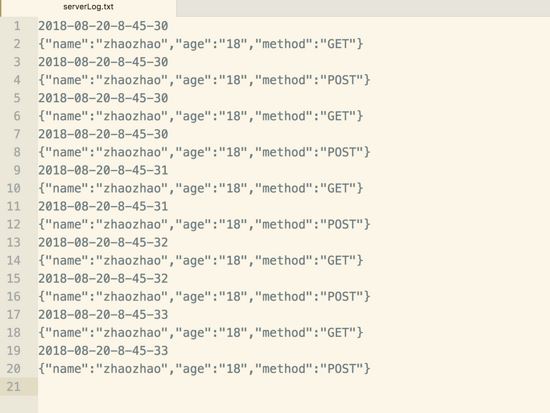nodejs 实现服务器 nodejs 怎样手动实现服务器
木子昭 人气:0这是一个连续的node学习笔记, 本文是第一章, 会持续更新, 持续完善
python好用,用久了就会把人的脾气养起来, nodejs不好用, 但效率很好, 也能彻底治好你的坏脾气
nodejs的回调是我用过的最蛋疼的编程方式之一, 但也足够巧妙, 学好node, 对一个程序员而言, 也是一个稳赚不赔的买卖
废话不多说, 上代码
1. 完成环境的搭建, 运行一个正则,提取字符串中的数字
let numRe = /\d+/g;
console.log("123dsgfas 12434 sdfasdf234dagsdfg".match(numRe));

nodejs的语法和浏览器js的语法非常接近, 安装好node后, 可以写个正则, 测试一下环境是否安装成功, 通过atom的script插件容易造成端口占用,建议学习过程中用命令行工具执行node脚本, 如 node HelloWorld.js
2. http模块开启一个服务
const http = require("http")
//开启一个监听8080端口的静态服务
http.createServer(function(req, res){
console.log("==>", req.url);
if (req.url === "/1.html"){
res.write("you have request 1.html");
}else if (req.url === "/2.html") {
res.write("you have request 2.html");
}else{
res.write("404(page not found)");
}
res.end();
}).listen(8080)
开启服务,分三步:
第一步: 引入模块
第二步: 调用模块http.createServer
第三步: 监听端口http.createServer(function(req, res){}).listen(8080)
3. fs模块读写文件
const fs = require("fs");
// 写入文件
fs.writeFile("HelloWorld.txt", "HelloWorld HelloNode", function(err){
if(err){
console.log(err);
}
// 读取刚刚写入的数据
else{
fs.readFile("HelloWorld.txt", function(err, data) {
if(err){
console.log(err);
}else{
console.log(data.toString());
}
})
}
})
简单读写文件非常简单, 与其它编程语言类似, 把调用方法背过就可以了
4.实现一个静态http服务器
const http = require("http");
const fs = require("fs")
http.createServer(function(req, res){
// 打开 www/ 目录下的文件
fs.readFile("./www/"+req.url, function(err, data) {
if(err){
console.log(err);
res.write("404");
res.end();
}else{
console.log(data.toString())
res.write(data);
res.end();
}
})
}).listen(8080)
通过了读取 www/ 目录下的文件, 实现了静态资源服务器
5.获取get数据
const http = require("http");
const url = require("url");
http.createServer(function(req, res){
let reqObj = url.parse(req.url, true)
let urlPath = reqObj.path;
let urlData = reqObj.query;
let log = "==>urlPath:" + urlPath +"==>>urlData:"+ JSON.stringify(urlData);
console.log(log);
res.write(log);
res.end();
}).listen(6060)
解析get请求的参数
6.获取post数据
const http = require("http");
const querystring = require("querystring");
http.createServer(function(req, res){
let dataStr = '';
let i = 0;
req.on("data", function(data){
dataStr+=data;
console.log(`第${i++}次收到数据`);
})
req.on("end", function(){
console.log("end");
let parseData = querystring.parse(dataStr);
console.log("parseData:", parseData);
res.write(new Buffer(dataStr, "utf8"));
res.end();
})
}).listen(8800)
解析post请求的参数
小结: 用已有知识 实现简单的服务器程序
const http = require("http");
const fs = require("fs");
const querystring = require("querystring");
/*
*1. 访问www内的静态资源
*2. 解析get请求, 并保存到serverLog.txt
*3. 解析post请求serverLog.txt
*/
// 获取当前时间
function getNowDate(){
let dt = new Date();
let year = dt.getFullYear();
let month = dt.getMonth();
let day = dt.getDate();
// 将月份加1
month = month + 1;
// 将月份补齐到两位
if (month <= 9){
month = "0" + month;
}
// 将日补齐到两位
if (day <= 9){
day = "0" + day;
}
let hour = dt.getHours();
let minutes = dt.getMinutes();
let seconds = dt.getSeconds();
return year+"-"+month+"-"+day+"-"+hour+"-"+minutes+"-"+seconds;
}
http.createServer(function(req, res){
// 1. 尝试访问www下的静态资源
fs.readFile("./www"+req.url, function(err, data){
if(err){
//2. 解析请求的参数, 并保存到log
if(req.method === "GET"){
console.log("收到了GET请求")
let getData = querystring.parse(req.url.split("?")[1]);
console.log("获得的get数据为==>",getData);
fs.writeFile("./serverLog.txt", getNowDate()+"\n"+JSON.stringify(getData)+"\n", {flag: 'a'},function(err){
if(err){
console.log(err);
console.log("GET数据保存至log出错");
}
});
}else if (req.method == "POST") {
console.log("收到了POST请求")
let tmpData = ''
req.on("data", function(data){
tmpData+=data;
});
req.on("end", function(){
let postData = querystring.parse(tmpData);
console.log("获得的post数据为==>", postData);
fs.writeFile("./serverLog.txt",getNowDate()+"\n"+JSON.stringify(postData)+"\n", {flag: 'a'},function(err){
if(err){
console.log(err);
console.log("POST数据保存至log出错");
}
});
})
}
res.write("404");
res.end();
}else{
res.write(data);
res.end();
}
})
}).listen(8000)
python测试脚本
import requests
requests.get("http://127.0.0.1:8000/?name=zhaozhao&age=18&method=GET")
requests.post("http://127.0.0.1:8000", data={"name": "zhaozhao", "age": 18, "method": "POST"})



熟悉了nodejs回调机制, 用原生nodejs写服务器程序是一件很有效率的事情 , 测试脚本还是requests好用!
加载全部内容